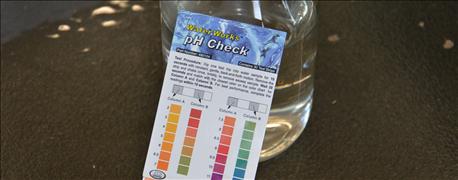
You’ve heard and read about water quality for spraying herbicides. You haven’t paid a lot of attention to it before, but you’re not satisfied with your weed control in all cases either. Maybe the issue deserves more attention.
But it sounds like chemistry, and that wasn’t your best subject at school. Even the part you understood seemed boring. Fred Whitford, Purdue University director of Pesticide Programs, says it may not be exciting, but it could make you thousands of dollars, simply because you get better weed control and thus better yields.
Here’s a primer that will help you get started on understanding why it matters, and how you can use this knowledge to your advantage.

TEST FOR pH: The top square on this litmus strip tests for pH. It is showing that the water in this sample is just slightly above neutral, at a pH slightly above 7.0.
Water hardness vs. pH
Water hardness and pH are two different things, Whitford insists. “They have no direct correlation to each other,” he says. “You need to deal with both separately when it comes to water quality."
If you test for pH and add something to adjust it, you’re not affecting water hardness, Whitford says. However, Bryan Young, Purdue weed control specialist, says that some products added to correct hardness will also reduce the pH. They include ammonium sulfate, citric acid and phosphoric acid.
Why hard water reduces effectiveness
Calcium and magnesium ions bind to negatively-charged herbicides. Once they are bound together, the herbicide molecules are no longer effective. The effect is that the weed sees a reduced rate of herbicide. It would be the same as if you cut the rate and applied it in water that wasn’t hard.
How to correct hardness
You can buy liquid products that will correct hardness. Or you can use dry ammonium sulfate. Research results indicate that if water is very hard, ammonium sulfate works best. If water is around 400 parts per million or higher, add up to 17 pounds of ammonium sulfate per 100 gallons of water. Dry sprayable ammonium sulfate usually is sold in 51--pound bags.
For a 1,250 gallon spray tank, you would need about 212 pounds, which is about four and one-quarter bags.
How pH works
The pH is a measure of the acidity or alkalinity of a substance, Whitford says. Water has a pH of 7.0, which is neutral. If the pH is lower than 7.0, it is acidic, higher than 7.0, it is alkaline.
It is not a linear scale, Whitford explains. In other words, a pH of 6.0 is not just one times more acidic than neutral. It is 10 times more acidic than a pH of 7.0. A pH of 5.0 is 100 times more acidic than a neutral pH.
Why pH matters for herbicides
Most herbicides prefer to work in slightly acidic conditions, Whitford says. There are exceptions. A few may prefer alkaline conditions with the pH above 7.0. Most herbicide labels address pH issues, and should state at what pH range the herbicide works best.
If the pH is more acidic or alkaline than the herbicide prefers, it may cause the herbicide to break down faster, and not be as effective, says Bill Johnson, Purdue Extension weed control specialist.
How to correct water pH for herbicide applications
Products are available that can be added to lower or raise pH. If you have checked hardness and adjusted for it, your job is only half-finished. You also need to check pH.
Refer to the herbicide label before you add any adjuvants which might affect pH. Some manufacturers adjust for pH in the product they sell. Others do not. That’s why you need to read the label to know if you need to add something for pH adjustment or not. Whitford says that for glyphosate products in particular, make sure you know what the label of the specific product you’re using says about adjuvants.
Test for pH
Inexpensive kits using litmus paper are available to test for pH. Most Indiana water is alkaline, typically 7.5 or higher. However, one sample recently sent to Whitford from an Indiana well was barely above 7.0. He has also received samples at 9.0.
“My advice is to test pH of the solution after the herbicide is added and you are ready to spray,” Whitford says. “That’s what matters, because that’s what the plant sees. In this case, it’s really the pH of the spray solution, not of the spray water, that matters.”
However, Young takes a slightly different approach. He prefers testing pH of the water both before and after you add the herbicide. If you don’t test water pH before adding herbicide and the pH is very high, the herbicide could start to degrade in the tank before it gets sprayed.
One final note about water hardness
If you find your water is hard and add ammonium sulfate at the proper rate, the herbicide should then not be affected by the hard water when it is added to the tank. However, if you check hardness after adding ammonium sulfate, it will be the same as before because the minerals are still in the solution- just not tied up with the herbicide.
About the Author(s)
You May Also Like




